人教版2019选择性必修第二册Unit 1 Science and Scientists Listening and Speaking 课件(17张ppt内嵌音频)
文档属性
| 名称 | 人教版2019选择性必修第二册Unit 1 Science and Scientists Listening and Speaking 课件(17张ppt内嵌音频) | 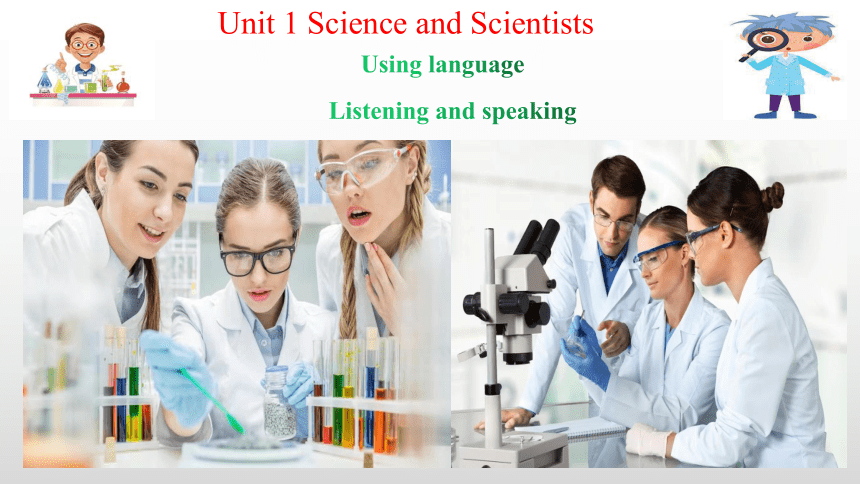 | |
| 格式 | pptx | ||
| 文件大小 | 6.7MB | ||
| 资源类型 | 教案 | ||
| 版本资源 | 人教版(2019) | ||
| 科目 | 英语 | ||
| 更新时间 | 2024-01-01 07:39:12 | ||
图片预览

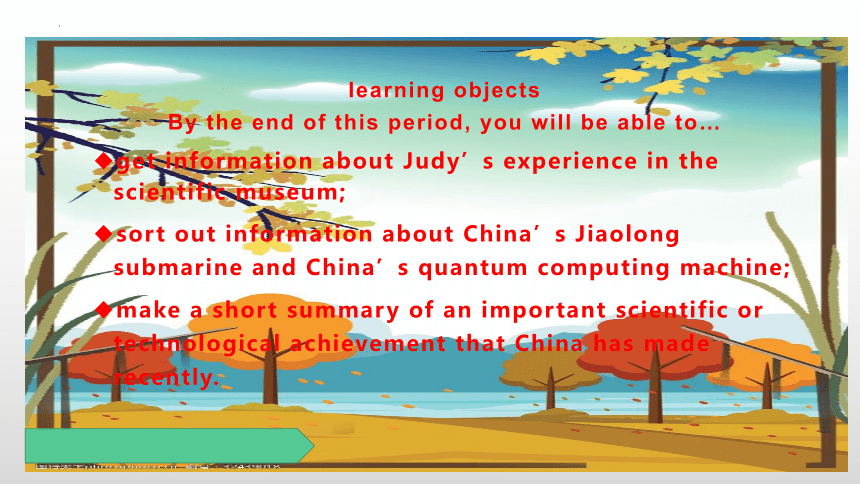
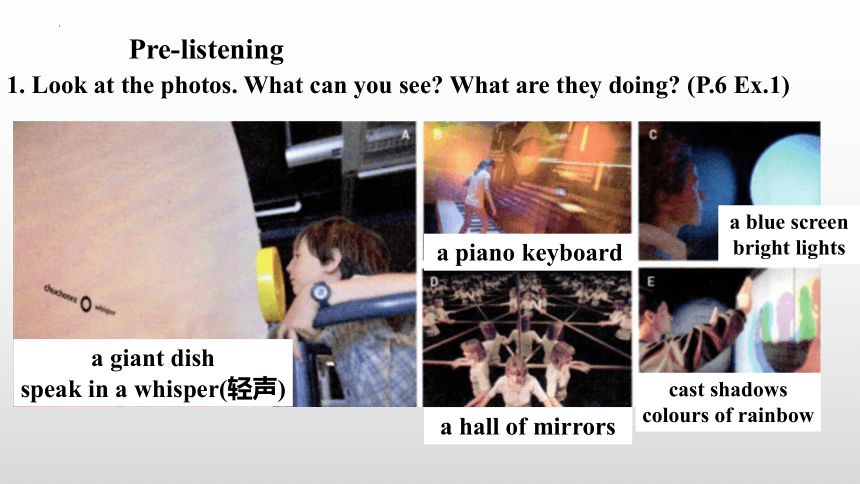
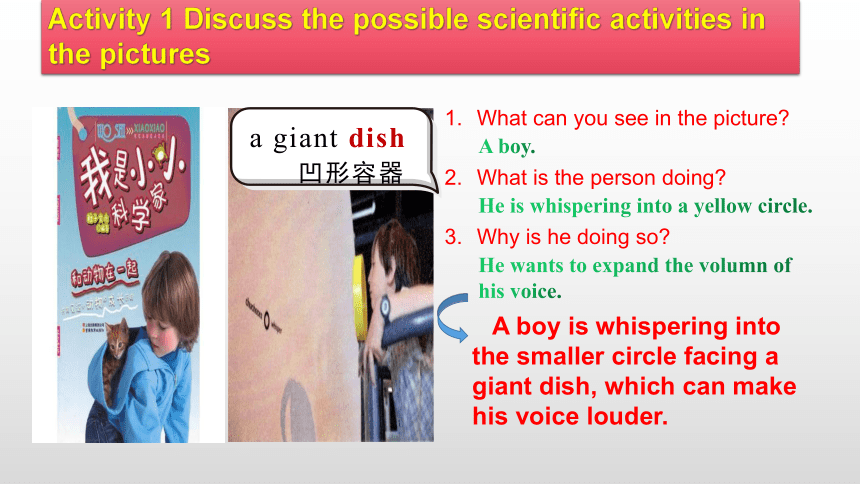
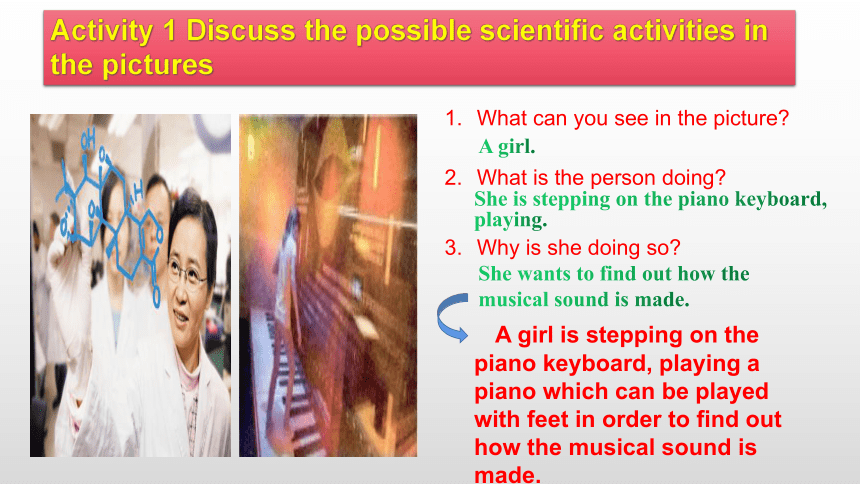
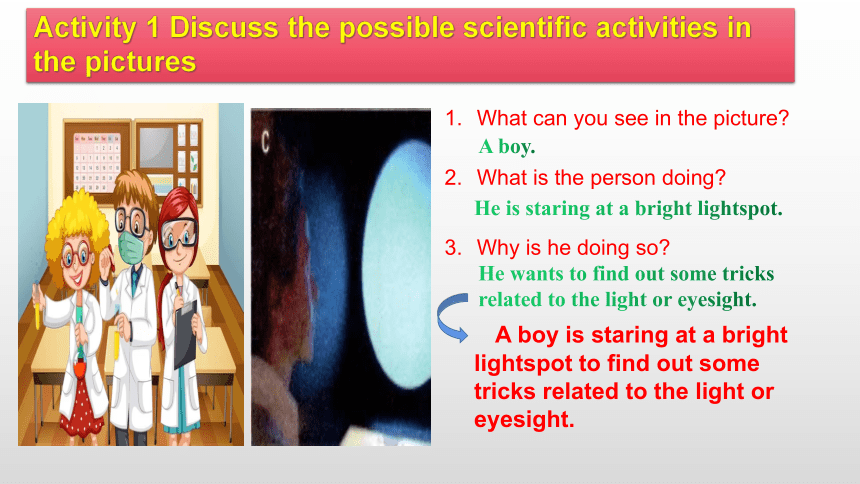
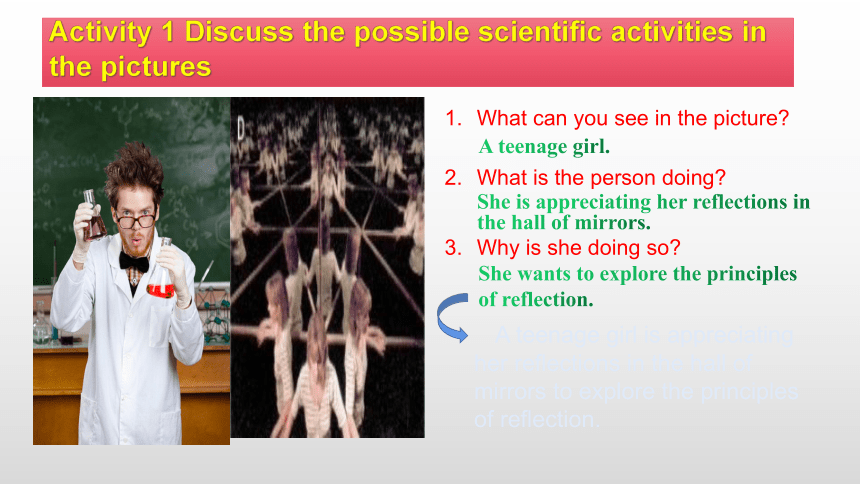
文档简介
(共17张PPT)
Unit 1 Science and Scientists
Using language
Listening and speaking
Iearning objects
By the end of this period, you will be able to…
get information about Judy’s experience in the scientific museum;
sort out information about China’s Jiaolong submarine and China’s quantum computing machine;
make a short summary of an important scientific or technological achievement that China has made recently.
Pre-listening
1. Look at the photos. What can you see What are they doing (P.6 Ex.1)
a giant dish
speak in a whisper(轻声)
a piano keyboard
a blue screen
bright lights
a hall of mirrors
cast shadows
colours of rainbow
Activity 1 Discuss the possible scientific activities in the pictures
A boy is whispering into the smaller circle facing a giant dish, which can make his voice louder.
a giant dish
凹形容器
What can you see in the picture
What is the person doing
Why is he doing so
A boy.
He is whispering into a yellow circle.
He wants to expand the volumn of his voice.
Activity 1 Discuss the possible scientific activities in the pictures
A girl is stepping on the piano keyboard, playing a piano which can be played with feet in order to find out how the musical sound is made.
What can you see in the picture
What is the person doing
Why is she doing so
She wants to find out how the musical sound is made.
A girl.
She is stepping on the piano keyboard, playing.
Activity 1 Discuss the possible scientific activities in the pictures
A boy is staring at a bright lightspot to find out some tricks related to the light or eyesight.
What can you see in the picture
What is the person doing
Why is he doing so
He wants to find out some tricks related to the light or eyesight.
He is staring at a bright lightspot.
A boy.
Activity 1 Discuss the possible scientific activities in the pictures
A teenage girl is appreciating her reflections in the hall of mirrors to explore the principles of reflection.
What can you see in the picture
What is the person doing
Why is she doing so
She wants to explore the principles of reflection.
She is appreciating her reflections in the hall of mirrors.
A teenage girl.
Activity 1 Discuss the possible scientific activities in the pictures
A teenage boy is lifting his arms and hands to see the colorful shadows cast on the wall. He might be conducting an experiment involving the composition of light.
What can you see in the picture
What is the person doing
Why is he doing so
He wants to conduct an experiment involving the composition of light.
He is lifting his arms and hands to see the colorful shadows cast on the wall.
A teenage boy.
Pre-listening
2. Using the photos, try to predict the answers to the following questions.
(P.6 Ex.2)
(1) Where are the people in the conversation going to go
(2) What kind of place is it, and what does it focus on
They are going to a science museum.
It is a science museum that focuses on letting visitors experience science through interactive(互动的) learning exhibitions.
Pre-listening
2. Using the photos, try to predict the answers to the following questions.
(3) What kinds of things can you do there
You can probably try different activities to learn about sound, light, reflection, and so on. For example, you can go to a room with many mirrors facing each other so it looks like there are many copies of you! You can also play with a big piano on the floor.
Predict by using pictures
One way to get more out of your listening is to predict what you will hear. Using the pictures provided and the knowledge you already have, you can guess the kinds of information you should listen for. At times, you may even be able to guess exactly what will be talked about. This will help you focus better when listening, making your listening more effective.
What can we predict in these pictures
1. Who What Where When
2. Can we classify them into different types
Picture A & B: sound; Picture C&D&E: light.
While-listening
1. Listen to the conversation and see if your answers for Activity 2 are correct. Then write down the letters (A-E) for the photos in the order that you hear them described. (P.6 Ex.3) TIP: Try to note down the key phrases.
1. _____
2. _____
3. _____
4. _____
5. _____
light games
a hall of mirrors
a blue screen
tiny bright lights
cast shadows
colours of rainbow
an area for sound
a piano keyboard
a giant dish
speak in a whisper
D
C
E
B
A
Located in Paris, France, the City of Science and Industry is the biggest science museum in Europe. The goal of the City is to spread scientific and technical knowledge among the public, particularly the youth, and to promote public interest in science, research and industry. Attractions include a planetarium, a submarine, an IMAX theatre and special areas for children and teenagers, where games, interactive exhibits, and experimental areas allow them to really get their thinking caps on to explore.
Cultural Note: the City of Science and Industry
n. 天文馆/,pl n ’te ri m/
n. 潜艇
/,s bm ’ri n/
开动脑筋
图片来源于网络
While-listening
4. Listen again and complete the descriptions of the photos. (P.6 Ex.4)
Photo A: A giant dish; when you speak into it, it __________ the sound back and
_______________. You can use it to speak in a _________ to someone 17 meters away.
Photo B: A giant ______________ that you can use your feet to play. Instead of playing the
sounds of a piano, it plays the voices of________________.
Photo C: You look at a blue screen for a while, and then suddenly you can see
________________ moving around on it. These are our_________________.
Photo D: A ________________ where you can see yourself reflected thousands of times.
Photo E: You stand in front of _____________ and it casts different shadows of you,
in ___________________ the rainbow.
reflects
makes it louder
whisper
piano keyboard
classical singers
tiny bright lights
own blood cells
hall of mirrors
a white light
every colour of
Post-listening
1. Answer the following questions about science museums. (P.7 Ex.5)
The conversation is about the City of Science and Industry, a museum
in Paris. Would you like to go to this museum Why or why not
(2) Are there any museums like this in China What can
you do in them
Yes, because the exhibitions seem really interesting. I think I would learn a lot about science and it can broaden my horizons(开拓视野).
Yes. For example, there is the China Science and Technology Museum (中国科学技术馆) in Beijing and the Guangdong Science Center (广东科学中心) in Guangzhou. We can do many interesting experiments in such museums.
图片来源于网络
图片来源于网络
Post-listening
2. Brainstorm and talk about a scientific experiment you are interested in.
TIP: You can refer to the sentence patterns provided. (P.7 Ex.6)
1.Opening: Today, I want to talk to you about a very strange phenomenon called a non-Newtonian fluid(非牛顿流体).
2.Materials needed: You can make it easily using equal parts of water and cornflour(矢车菊), like I have here.
3.Process: A non-Newtonian fluid is strange because you can pour it like a liquid, but if you put any pressure on it, it suddenly becomes hard as concrete(混凝土). In fact, it becomes hard enough to stand on. Then, as soon as you take the pressure off, it becomes a liquid again.
4.Theory: This shows that it is possible that something can exist as a liquid and a solid at the same time.
Talking about scientific phenomena
.. can/cannot exist in the form of a solid/gas and a liquid/plasma(血浆).
... is both a ... and a.. . at the same time …
how light/sound is reflected …
This occurs when ...
If you ..., it will become ...
That demonstrates(表明) ...
This experiment/research shows ...
Through this, we know that ....
We can prove that ...
This evidence proves …
Thank you
Unit 1 Science and Scientists
Using language
Listening and speaking
Iearning objects
By the end of this period, you will be able to…
get information about Judy’s experience in the scientific museum;
sort out information about China’s Jiaolong submarine and China’s quantum computing machine;
make a short summary of an important scientific or technological achievement that China has made recently.
Pre-listening
1. Look at the photos. What can you see What are they doing (P.6 Ex.1)
a giant dish
speak in a whisper(轻声)
a piano keyboard
a blue screen
bright lights
a hall of mirrors
cast shadows
colours of rainbow
Activity 1 Discuss the possible scientific activities in the pictures
A boy is whispering into the smaller circle facing a giant dish, which can make his voice louder.
a giant dish
凹形容器
What can you see in the picture
What is the person doing
Why is he doing so
A boy.
He is whispering into a yellow circle.
He wants to expand the volumn of his voice.
Activity 1 Discuss the possible scientific activities in the pictures
A girl is stepping on the piano keyboard, playing a piano which can be played with feet in order to find out how the musical sound is made.
What can you see in the picture
What is the person doing
Why is she doing so
She wants to find out how the musical sound is made.
A girl.
She is stepping on the piano keyboard, playing.
Activity 1 Discuss the possible scientific activities in the pictures
A boy is staring at a bright lightspot to find out some tricks related to the light or eyesight.
What can you see in the picture
What is the person doing
Why is he doing so
He wants to find out some tricks related to the light or eyesight.
He is staring at a bright lightspot.
A boy.
Activity 1 Discuss the possible scientific activities in the pictures
A teenage girl is appreciating her reflections in the hall of mirrors to explore the principles of reflection.
What can you see in the picture
What is the person doing
Why is she doing so
She wants to explore the principles of reflection.
She is appreciating her reflections in the hall of mirrors.
A teenage girl.
Activity 1 Discuss the possible scientific activities in the pictures
A teenage boy is lifting his arms and hands to see the colorful shadows cast on the wall. He might be conducting an experiment involving the composition of light.
What can you see in the picture
What is the person doing
Why is he doing so
He wants to conduct an experiment involving the composition of light.
He is lifting his arms and hands to see the colorful shadows cast on the wall.
A teenage boy.
Pre-listening
2. Using the photos, try to predict the answers to the following questions.
(P.6 Ex.2)
(1) Where are the people in the conversation going to go
(2) What kind of place is it, and what does it focus on
They are going to a science museum.
It is a science museum that focuses on letting visitors experience science through interactive(互动的) learning exhibitions.
Pre-listening
2. Using the photos, try to predict the answers to the following questions.
(3) What kinds of things can you do there
You can probably try different activities to learn about sound, light, reflection, and so on. For example, you can go to a room with many mirrors facing each other so it looks like there are many copies of you! You can also play with a big piano on the floor.
Predict by using pictures
One way to get more out of your listening is to predict what you will hear. Using the pictures provided and the knowledge you already have, you can guess the kinds of information you should listen for. At times, you may even be able to guess exactly what will be talked about. This will help you focus better when listening, making your listening more effective.
What can we predict in these pictures
1. Who What Where When
2. Can we classify them into different types
Picture A & B: sound; Picture C&D&E: light.
While-listening
1. Listen to the conversation and see if your answers for Activity 2 are correct. Then write down the letters (A-E) for the photos in the order that you hear them described. (P.6 Ex.3) TIP: Try to note down the key phrases.
1. _____
2. _____
3. _____
4. _____
5. _____
light games
a hall of mirrors
a blue screen
tiny bright lights
cast shadows
colours of rainbow
an area for sound
a piano keyboard
a giant dish
speak in a whisper
D
C
E
B
A
Located in Paris, France, the City of Science and Industry is the biggest science museum in Europe. The goal of the City is to spread scientific and technical knowledge among the public, particularly the youth, and to promote public interest in science, research and industry. Attractions include a planetarium, a submarine, an IMAX theatre and special areas for children and teenagers, where games, interactive exhibits, and experimental areas allow them to really get their thinking caps on to explore.
Cultural Note: the City of Science and Industry
n. 天文馆/,pl n ’te ri m/
n. 潜艇
/,s bm ’ri n/
开动脑筋
图片来源于网络
While-listening
4. Listen again and complete the descriptions of the photos. (P.6 Ex.4)
Photo A: A giant dish; when you speak into it, it __________ the sound back and
_______________. You can use it to speak in a _________ to someone 17 meters away.
Photo B: A giant ______________ that you can use your feet to play. Instead of playing the
sounds of a piano, it plays the voices of________________.
Photo C: You look at a blue screen for a while, and then suddenly you can see
________________ moving around on it. These are our_________________.
Photo D: A ________________ where you can see yourself reflected thousands of times.
Photo E: You stand in front of _____________ and it casts different shadows of you,
in ___________________ the rainbow.
reflects
makes it louder
whisper
piano keyboard
classical singers
tiny bright lights
own blood cells
hall of mirrors
a white light
every colour of
Post-listening
1. Answer the following questions about science museums. (P.7 Ex.5)
The conversation is about the City of Science and Industry, a museum
in Paris. Would you like to go to this museum Why or why not
(2) Are there any museums like this in China What can
you do in them
Yes, because the exhibitions seem really interesting. I think I would learn a lot about science and it can broaden my horizons(开拓视野).
Yes. For example, there is the China Science and Technology Museum (中国科学技术馆) in Beijing and the Guangdong Science Center (广东科学中心) in Guangzhou. We can do many interesting experiments in such museums.
图片来源于网络
图片来源于网络
Post-listening
2. Brainstorm and talk about a scientific experiment you are interested in.
TIP: You can refer to the sentence patterns provided. (P.7 Ex.6)
1.Opening: Today, I want to talk to you about a very strange phenomenon called a non-Newtonian fluid(非牛顿流体).
2.Materials needed: You can make it easily using equal parts of water and cornflour(矢车菊), like I have here.
3.Process: A non-Newtonian fluid is strange because you can pour it like a liquid, but if you put any pressure on it, it suddenly becomes hard as concrete(混凝土). In fact, it becomes hard enough to stand on. Then, as soon as you take the pressure off, it becomes a liquid again.
4.Theory: This shows that it is possible that something can exist as a liquid and a solid at the same time.
Talking about scientific phenomena
.. can/cannot exist in the form of a solid/gas and a liquid/plasma(血浆).
... is both a ... and a.. . at the same time …
how light/sound is reflected …
This occurs when ...
If you ..., it will become ...
That demonstrates(表明) ...
This experiment/research shows ...
Through this, we know that ....
We can prove that ...
This evidence proves …
Thank you
